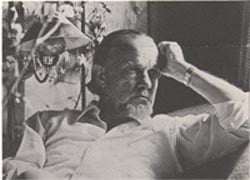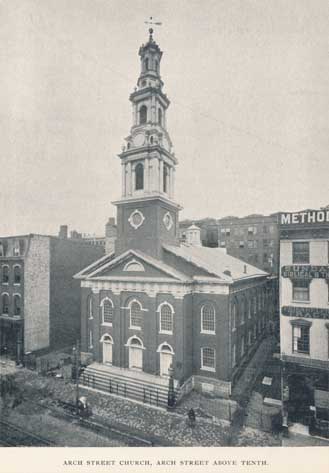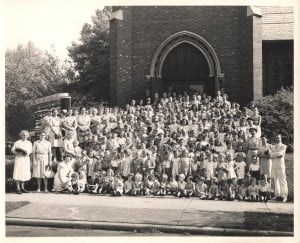This day, January 30, marks the birth of Francis August Schaeffer, in 1912.
 Dr. Schaeffer began his ministry with the Bible Presbyterian Church, was later a minister in the Reformed Presbyterian Church, Evangelical Synod, and when that denomination was received into the PCA, spent his final few years, from 1982 until his death in 1984, affiliated with the PCA. Dr. Schaeffer was the featured speaker at the 1980 “Consultation on Presbyterian Alternatives” sponsored by the Presbyterian Church in America. His counsel, excerpted here from the full transcript of his Pittsburgh messages, was heard by participants from several Presbyterian communions. Admittedly another long post today, but please save it to read tomorrow if you don’t have time today.
Dr. Schaeffer began his ministry with the Bible Presbyterian Church, was later a minister in the Reformed Presbyterian Church, Evangelical Synod, and when that denomination was received into the PCA, spent his final few years, from 1982 until his death in 1984, affiliated with the PCA. Dr. Schaeffer was the featured speaker at the 1980 “Consultation on Presbyterian Alternatives” sponsored by the Presbyterian Church in America. His counsel, excerpted here from the full transcript of his Pittsburgh messages, was heard by participants from several Presbyterian communions. Admittedly another long post today, but please save it to read tomorrow if you don’t have time today.
“We Don’t Have Forever.”
BY DR. FRANCIS A. SCHAEFFER (1980; REPRINTED FROM THE PCA MESSENGER)
Two biblical principles must be practiced simultaneously, at each step of the way, if we are to be really Bible-believing Christians. One is the principle of the practice of the purity of the visible church. The other is the principle of an observable love among all true Christians.
Those of us who left the old Presbyterian Church USA (the “Northern” Church) 44 years ago made mistakes which marked the movement for years to come. The second principle often was not practiced. In particular we often failed to manifest an observable love for the fellow believers who stayed in that denomination when others of us left.
Things were said which are very difficult to forget even more than 40 years later. The periodicals of those who left tended to spend more time attacking the real Christians who stayed in the old denomination than in dealing with the liberals. Those who came out at times refused to pray with those who had not come out. Many who left totally broke off all forms of fellowship with true brothers in Christ who did not come out.
What was destroyed was Christ’s command to love each other. And what was left was often a turning inward, a self-righteousness, a hardness, and, too often, a feeling that withdrawal had made those who came out so right that anything they did could be excused.
Further, having learned these bad habits, they later treated each other badly when the new groups had minor differences among themselves.
We cannot stress both of the principles simultaneously in the flesh. Sometimes we stress purity without love. Or we can stress love without purity. In order to stress both simultaneously we must look moment to moment to the work of Christ and to the work of the Holy Spirit. Without this, a stress on purity becomes hard, proud, and legalistic. Without this, a stress on love becomes compromise. Spirituality begins to have real meaning in our lives as we begin to exhibit (and the emphasis here is on exhibit, not just talk) simultaneously the holiness of God and the love of God. Without our exhibition of both, our marvelous God and Lord is not set forth. Rather, a caricature is set forth and He is dishonored.
We paid a terrible price for what happened in those early days. As some of you now come out of your denominations, please do learn from our mistakes. Each pastor, each congregation must be led by the Holy Spirit. If some disappoint you, do not turn bitter.
One of the joys of my life occurred at the Lausanne Congress (the 1974 International Congress on World Evangelization in Lausanne, Switzerland). Some men from the newly formed Presbyterian Church in America asked me to attend a meeting they and others had called there. When I arrived I found that it was made up of Southern men who had just left the Presbyterian Church US to form the PCA and some Christians who were still in the PCUS. Someone from each side spoke. Both said to me that the meeting was possible because of my voice and especially my little book, The Church Before the Watching World (published by InterVarsity Press). I must say I could have wept, and perhaps I did. It is possible for us to do better than we would naturally do. It is not possible if we ignore the fleshly dangers and fail to look to our living Lord for his strength and grace.
Those of us who left our old denomination in the Thirties had another great problem, as I see it. It was confusion over where to place the basic chasm which marks off who we are. Does that chasm mark us as those who are building Bible-believing churches and that on this side of the chasm we hold the distinctives of being Presbyterian and Reformed? Or is the primary chasm that we are Presbyterian and Reformed and that we are divided from all who are not? The answer makes a great deal of difference.
When we go to a town to start a church, are we going there with the primary motivation to build a church which is loyal to Presbyterians and the Reformed faith, or are we going there to build a church which will preach the Gospel which historic, Bible-believing Christianity holds, and then on this side of that chasm teach that which we believe is true to the Bible in regard to church government and doctrine? The difference makes a difference to our mentality, to our motivation, and to the breadth of our outreach. I must say, to me one view is catholic, biblical and gives good promise of success; the other is introverted and self-limiting, yes, and sectarian. I spoke of a good promise of success. I mean on two levels: First in church growth and a healthy outlook among those we reach; second, in providing leadership in the whole church of Christ.
We alone do not face this problem of putting the chasm at the wrong place, of course. A too zealous mentality on the Lutheran view of the sacraments is the same. A too sectarian mentality in regard to the mode of baptism is another. The zeal of the Plymouth Brethren for an unpaid ministry is often the same. No, it is not just our problem. But it is our problem. To put the chasm in the wrong place is to fail to fulfill our calling, and I am convinced that when we do so we displease our Lord.
Those who remain in the old-line churches have their own set of problems. In contrast to the problem of hardness to which those who withdraw are prone, those who remain are likely to develop a general latitudinarianism. One who accepts ecclesiastical latitudinarianism easily steps into a cooperative latitudinarianism which can become a doctrinal latitudinarianism and especially a letdown on a clear view of Scripture.
This is what happened in certain segments of what I would call the evangelical establishment. Out of the evangelical latitudinarianism of the Thirties and Forties grew the letdown in regard to the Scripture in certain areas of the evangelical structure in the Seventies. Large sections of evangelicalism today put all they can into acting as though it makes no real difference as to whether we hold the historic view of Scripture or the existential view. The existential methodology says that the Bible is authoritative when it teaches “religious” things but not when it touches that which is historic, scientific, or such things as the male/female relationship.
Not all who have stayed in the liberal denominations have done this, by any means, but it is hard to escape. I don’t see how those who have chosen to stay in (no matter what occurs) can escape a latitudinarian mentality which will struggle to paper over the differences on Scripture in order to keep an external veneer of unity. That veneer in fact obscures a real lack of unity on the crucial point of Scripture. And when the doctrinal latitudinarianism sets in we can be sure from all of church history and from observation in our own period of church history that in just a generation or two the line between evangelical and liberal will be lost.
This is already observable in that the liberals largely have shifted to the existential methodology and have expressed great approval that the “moderate evangelicals” have done so. The trend will surely continue. Unless we see the new liberalism with its existential methodology as a whole, and reject it as a whole, we will, to the extent to which we tolerate it, be confused in our thinking. Failure to reject it will also involve us in the general relativism of our day and compromising in our actions.
The second major problem of those who stay in the liberally controlled denominations is the natural tendency to constantly move back the line at which the final stand will be taken. For example, can you imagine Clarence Macartney, Donald Grey Barnhouse or T. Roland Phillips being in a denomination in which the battle line was the ordination of women? Can you imagine these great evangelical preachers of the Twenties and Thirties (who stayed in the Presbyterian Church USA) now being in a denomination which refuses to ordain a young man whose only fault was that while he said he would not preach against the ordination of women yet he would not say he had changed his mind that it was unbiblical? Can you imagine that these leaders of the conservative cause in an earlier era would have considered it a victory to have stalled the ordination of practicing homosexuals and practicing lesbians? What do you think Macartney, Barnhouse, and Phillips would have said about these recent developments? Such a situation in their denomination would never have been in their minds as in the realm of conceivable.
The line does move back. In what presbytery of the Northern Presbyterian Church can you bring an ordained man under biblical discipline for holding false views of doctrine and expect him to be disciplined?
Beware of false victories. Even if a conservative man is elected moderator of the general assembly (as Macartney was in 1924), it would amount to absolutely nothing. Despite the jubilation among conservatives at Macartney’s election, the bureaucracy simply rolled on, and not too many years later conservative leader J. Gresham Machen could be unfrocked. Nelson Bell was elected moderator of the Southern Church later (in 1972), and nothing changed. The power centers of the bureaucracy and the liberally-controlled seminaries were unmoved.
There are always those who say, “don’t break up our ranks … wait a while longer … wait for this … wait for that.” It is always wait. Never act. But 40 years is a long time to wait when things are always and consistently getting worse. And (with my present health problem) I tell you soberly, we do not have forever to take that courageous and costly stand for Christ that we sometimes talk about. We do not have forever for that. We hear many coaxing words, but watch for the power structure to strike out when it is threatened. If the liberals’ power is really in danger or if they fear the loss of property, watch out!
What of the future? We live in a day that is fast-moving. The United States is moving at great speed toward totally humanistic orientation in society and state. Do you think this will leave our own little projects, our own church, and our own lives untouched? Don’t be silly. The warnings are on every side. When a San Francisco Orthodox Presbyterian congregation can be dragged into court for breaking the law of discrimination because it dismissed an avowed, practicing homosexual as an organist, can we be so blind as to not hear all the warning bells go off? When by a ruling of a federal court the will of Congress can be overturned concerning the limitation on the willful killing of unborn children, should not the warning bells go off as to the kind of pressures ahead of us?
Who supports these things? The liberal denominations do, publicly, formally, and financially. And it puts into a vise those of us who stand for biblical morality, let alone doctrine. Beyond the denominations, it is their councils of churches that support not only these things but also terrorist groups. They give moral support and money. Should we support this by our denominational affiliation? We may seem isolated from the results for a time but that is only because we are too blind to see.
I don’t think we have a lot of time. The hour is very late, but I don’t think it is too late in this country. This is not a day of retreat and despair. In America it is still possible to turn things around. But we don’t have forever.


